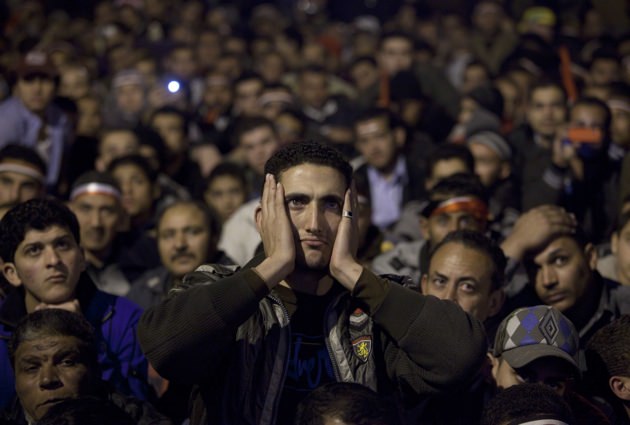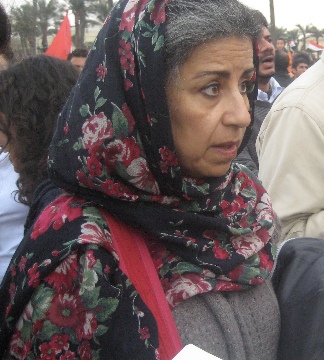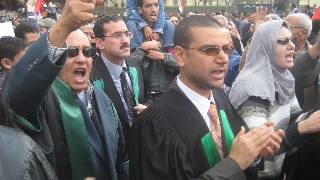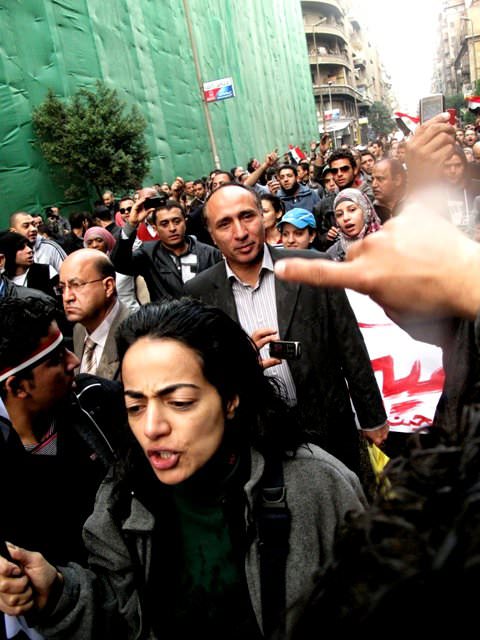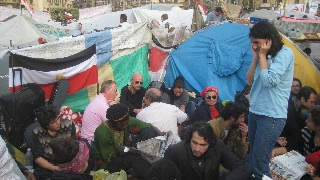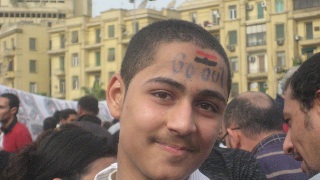On Thursday evening, sixteen days after thousands of Egyptians converged on Cairo’s central square to bring an end to a thirty-year-old dictatorship, it seemed that the moment we had been waiting for had finally come. Around 6 PM, rumors began circulating that Mubarak was preparing to step down, and later, Egyptian State TV confirmed he would be making an announcement—his second since the protests began. People started to pour into the streets near Tahrir Square shouting “Yay, yay, yay, Hosni is leaving today,” and cars were honking as if in victory.
As the evening went on and the speech was delayed, however, the crowd became quieter, many murmuring fears that perhaps the resignation wouldn’t happen. Some people sat on the pavement of Tahrir, others stood, waiting and anxious. Standing near me, Shahira Amin—the news anchor who resigned from her State television post last week to protest the government’s propaganda—said her stomach was in knots. When the speech began at last, a little after 11 PM—broadcast on loudspeakers across the square—it was quickly apparent that Mubarak was not going to concede much of anything. At first, people listened in stunned silence as he rambled on about “those” who were responsible for the violence being held to account. When he spoke of “foreign interference” some minutes into the speech, the crowd booed. People began to shout when he mentioned handing powers to longtime regime insider and now Vice President Omar Suleiman. And they erupted in anger when it became clear that he had no plans to step down.
When it ended, the people gathered around the square broke into piercing chants: “We don’t want dialogue, we just want you out.” One man said Mubarak was “a donkey who just doesn’t understand.” Another threw his hands in the air, shouting, “what planet is he on, he’s crazy.” Beside me, a friend recalled a statement the president made several years ago, when he said “I have a PhD in stubbornness.” The crowd was furious and began marching out of Tahrir, shouting “tomorrow, tomorrow, tomorrow.” Many, in no mood to wait for Friday, began to march toward the State TV building and other locations around the city.
It was yet one more unforeseeable turn in a protest movement that has changed character and momentum almost daily. As recently as Monday afternoon, I had left Tahrir Square thinking that the revolution might be over. At that point, the crowds had thinned greatly since the weekend, exhaustion hung on many faces, and everywhere I turned, people seemed to be arguing about who was speaking on their behalf and what would have to be done to keep the protests going. Every person among those still in the square had an opinion, and there was a pervasive sense that the movement was breaking up. I left the square dejected—by the mood, and also by the plainclothes state security informants who seemed to be everywhere again. On my way back, I was stopped several times, and when I got home, several of them were lurking outside.
By Monday evening, however, the dynamic had shifted again. Wael Ghonim—the Google marketing executive who had been detained since one of the first protests—was released, and interviewed live on Egypt’s Dream TV. Ghonim, who created the Facebook page ‘We are All Khaled Said’ that called for the original January 25 protests, gave a moving account of his twelve days held blindfolded in a detention center, during which he was interrogated daily. Everyone that evening was watching the broadcast—even in Tahrir Square itself, where, having withstood last week’s violent crackdown, protesters had set up a more permanent encampment of sound stages, television screens, and food stands. Wael had been an active member in the movement for change, and everyone had been wondering where he was, what they had done to him—even if he would turn up alive.
In his interview, Wael appeared shaken. He felt burdened by the events his Facebook page had unleashed—by the blood that had been shed and the many lives lost. Almost every Egyptian newspaper had been filled with stories and pictures of those killed in the protests. A memorial web page had also been set up: Fractured skull after being run over by a van, age 18. Hit in the back of the head with a bat, age 23. Shot on Abas El Aqqad Street, age 16. Gunshot to the heart. Hit by a police car, age 20. Shot while protecting his home, age 23. Shot in the head, shot in the stomach, killed by police, ten bullets to the heart, one to the lung. Father of three.
Advertisement
Wael knew all this, and as his interviewer flashed shots of the victims on a screen, he broke into tears. “I want to tell every mother and every father, truthfully, of the people who died,” he said. “I am so sorry. I swear to God, it’s not our fault, it’s the fault of those who are in charge of the country and who don’t want to leave their positions.” He then dropped his head to his hands before running off the set. Minutes after the interview was over, Twitter and Facebook were filled with calls for all Egyptians to take to the streets the following day, “for Wael Ghonim.” A young man tweeted that he had only seen his father cry twice in his life, “Once when his mother died, and just now. #egypt #jan25.” Many who had so far only watched the events of Tahrir unfolding on TV, posted Facebook updates saying that tomorrow they would be out on the streets. My mother, who had watched it all with fear until now, said she “would like to go too.”
Tuesday morning, I headed to the downtown office of Aida Seif El Dawla, the human rights activist and director of the Nadim Centre for victims of violence. I was with a journalist friend, Elizabeth Rubin, and our plan was to tag along with Aida to a protest by university faculty, who were meeting by a downtown hospital and marching to Tahrir. It was the first time that university staff were joining the protests en masse, and Aida—herself a professor of psychiatry—was eager to take part. She was certain that we had reached a new point in the confrontation with the regime. On the way, she told us some of the things she had witnessed over the week. At one point, as she had passed the now charred headquarters of Mubarak’s National Democratic Party, four armed men had pointed guns at her, threatening to shoot. At another moment, armed soldiers came to the door of her clinic, demanding to search it. Aida, an activist who has been battling the government for years, refused to let them in. “That’s where grey hairs come in handy,” she laughed.
Women had begun to take on a special importance in the protest movement, and over the weekend I watched hundreds of women circle Tahrir Square chanting for equality—most of them veiled. Men had stood aside, cheering them on. The last time Egypt had witnessed this was probably 1919, when the feminist Huda Sharaawi led a women’s march, also downtown, also by parliament, demanding the same. “It’s incredible,” the novelist Ahdaf Soueif, who was there, had told me. “We are seeing women being treated as citizens. In fact, we are thinking of issuing a statement, as women, asking to end this gender predicament once and for all.” People flocked around Ahdaf, sharing stories about one-room apartments that accommodate 6-person families. One man begged her to get a TV crew to film his home, pleading that he was willing to work, willing to earn on honest wage, willing to put in long hours. Beside us, people had shouted out in rhyming chants that First Lady Suzanne Mubarak needed to tell her husband that “thirty years is more than enough,” and explain to him that a kilo of meat now costs $18.
On Tuesday, thanks to Wael Ghonim, that same energy was returning. By the time we reached the university protest, it was already several hundred people strong. There were deans, administrative staff, directors of research institutes, and prominent scholars, including the political analyst Mustapha El-Sayyed, who was there with his wife “to try to revive what we felt was a loss of momentum and impasse.” As we walked, Mustapha said that the regime had lost its legitimacy, pointing out that supporters of the government were themselves now leaving it. “Even Osama El Baz was in Tahrir,” he said of the president’s former advisor. “We came out today because we felt we had to support the youth. Their demands are legitimate, and this is important. We have to inject energy back into this.” As he said this, he disappeared into the crowd, pumping his fists in the air, shouting, “the people have already overthrown the regime, the people have already overthrown the regime.” Beside him, a woman in a baby-blue veil was shrieking too, as if years of pent-up frustration were finally coming out. It seemed to be the story of many.
As we marched down Kasr El Aini Street, people cheered us on. The crowd chanted for people to join, for the speaker of parliament to go, for the House to be dissolved, and for the government to depart. As we passed parliament—housed in a 19th-century palace—employees came to the building’s large wrought-iron gates and took pictures of us with their phones. The crowds chanted “Frauds!” At the Prime Minister’s office, employees peeked from their windows and watched from balconies. And then further down, by a building belonging to the ministry of health, employees leaned out of windows, cheering us on. Around the corner, near the ministry of interior, four soldiers sitting in the back of an olive-green state security truck smiled at us. The driver, also in uniform, nodded his head and said “May God be with you—God willing, success for you.”
Advertisement
Tahrir, when we finally arrived there around 1:30 PM, was heaving again—more people out, it seemed, than even for the “million man” march one week earlier. I spotted artists, writers, lawyers, bankers, professors, and the wives and children of prominent businessmen—some with their husbands, and others alone since their spouses were still at work, having returned on Sunday when businesses had reopened. Some men circled the square with young children on their shoulders—the children holding speakers, flags, and leading chants. I saw the producer Mona Assad, and was told that the filmmaker Tahani Rached had just left. Jehane Noujaim—a documentary filmmaker who had been detained last week—was also there, as was Hazem, the son of Arab League secretary-general Amr Moussa. At one point, dozens of judges—dressed in their gowns—walked through the crowds to roaring applause. Someone said that the TV anchor Amr Adeeb, once close to the regime, had also been there, but was booed away by the crowd. Wael Ghonim was also around, but I couldn’t find him anywhere.
My friend and I walked around dazed for a while, trying to comprehend the sudden surge of enthusiasm for a revolution that had seemed to be fading. We walked passed face-painting stands (where people could be painted with the Egyptian flag or other slogans), vendors selling flags, displays of anti-regime cartoon posters, candy carts, drink stands, and a shrine for victims of last week’s pro-Mubarak violence made from colored rocks, flower petals, and posters. Past the growing sea of tents—some bought for LE150 ($26) from a local Carrefour, many others home made constructions of nylon wrap—we took note of tent names: Freedom House, Pension Liberation, House of Truth. Children played in what little space was left in the square, and men in costumes mingled. One, dressed for the Muslim Haj, circled the square as if on pilgrimage. Another was decked out like a referee—he blew his whistle and held up a large red penalty card with the word “OUT” on one side and ‘Mubarak’ on the other.
On Wednesday, I headed to Tahrir late. A well-known choreographer, Karima Mansour, had called me saying she wanted to talk, but wouldn’t say about what. “When you get here,” she told me. Karima, whose work has dealt with political oppression, had been persecuted under the Mubarak regime, and struggled for years before she was allowed to leave the country. When I arrived at the square, just after 6 PM, I found her deep in a meeting with a group of seasoned activists and filmmakers. They were devising strategy: how to get the revolution beyond the bounds of Tahrir, how to identify a leader for the movement, figuring out what public space or government property they should take over next. They had already planned a protest in front of the Cinema Syndicate on Thursday, and were discussing how to increase the number of protesters now camping outside parliament. Over a couple of hours Wednesday evening, other words flew: march, unplanned, presidential palace, parliament, minister of culture, savage, trial, Habib El Adly—the reviled interior minister whom Mubarak had dismissed the week before. They discussed Omar Suleiman, his threats of a military coup, his statement that Egyptians were not ready for democracy, and his interview when he said he would ask “the parents to tell their children to go home.” Karima was furious, more determined than ever to bring the regime down and ensure that the former ministers paid for years of corruption. “I cancelled a performance in Europe to come back here. There is no way I’m going anywhere,” she said.
As the activists met, by the growing mass of tents for those who had been in the square for two weeks now, the rest of Tahrir had taken on a carnival-like atmosphere again. Four stages had been set up in different corners of the square for performers. Someone explained that one was for the Muslim Brotherhood, one for the Mawred Thaqafy, a local cultural center, one was a youth stage, and the fourth, she wasn’t sure. “The Ikhwan [Brothers] have all sorts of performers, mainly popular music. Forget this Western idea of the Muslim Brothers as big bad wolves. They are just like us here.” People were coming out in costume, holding banners, cartoon strips, and portable installation art. One man held up two boots that were pinned with notes telling Mubarak he was kicking him out. Another held a sign that said, “Mubarak, Shift+Delete.” Many hoisted posters with the word “get out” in different languages—just in case Mubarak doesn’t understand.
The violence that had been inflicted on the protesters last week had been replaced by creativity; street art, long banned, was everywhere. Many I spoke to said it was the first time in their lives that they felt they had a voice, ideas, a part to play in the life of the country. Every person now seemed to count, and there was no difference, they said, between man or woman, Coptic or Muslim, rich or poor. “This is who we are,” one woman told me,
The government spent years feeding us lies, about tension between religions, about how we have no voices, about how women are lesser to men. They made us scared to express ourselves, and we lost touch with who we are. But look, here we are, all together, seen as citizens, equal. This is the truth of who Egyptians are.
Regardless of who ends up as their leader, Egyptians—at least the few million out protesting, and myself included—are fundamentally changed. On Facebook yesterday, the wife of the former Prime Minister wrote, “No one can deny how creative Egyptians are,” and posted a video of a dance at the square.
Thursday morning, despite rumors that Vice President Suleiman was preparing the army to crackdown on demonstrators, there were reports of plans for more protests. The government, we felt, seemed increasingly anxious about what was to come. Workers were striking in Suez, Mahalla, and other industrial cities. Postal workers were protesting, and government telecom employees were demanding that the president step down. Professional unions and syndicates had begun to align themselves with the revolution, and medical students and doctors staged a march in their white coats, from a public hospital, down to Tahrir. Someone tweeted “I counted 16 different strikes in two days, 4 in factories owned by army, more to come,” and another, “Almost all public transportation garages in Cairo are on strike now #Jan25 #Egypt #revolution”. Above all, people were talking about this week’s Friday protests, “Defiance Day,” which were supposed to be the biggest yet, with calls for 15-20 million people to take to the streets across the country after Friday Prayers.
As I write this, at 1:40 AM, just back from Tahrir following Mubarak’s speech, Twitter and Facebook are ablaze—with updates of the movement of protesters that are now marching through Cairo, and as well with insults directed at the president and plans for tomorrow.
I have seen #Mubarak singlehandedly let down 1 million ppl right in front of my eyes. I will not forgive for that #Jan25
About 20 thousand now surrounding TV building calling for Mubarak’s immediate departure: now and not tomorrow
BREAKING: New Facebook upgrade option is called Mubarak. You click on quit and nothing happens.
And Mohamed ElBaradei wrote, “Egypt will explode. Army must save the country now.” In reply to the former IAEA chief, activists tweeted, “SHUT UP. Go back to Vienna.”
The protesters, who are marching towards the presidential palace in Heliopolis, northeast of central Cairo, and have now surrounded the State TV building, remain committed to nonviolence. But there is widespread anger, and ahead of the expected turnout after Friday prayers, the nation was holding its breath. Already, there were reports of gunfire, heard around the presidential palace. When my friend and I marched with Aida Seif earlier this week, she had said that if Suleiman takes power, “we will all be bacon.” In the early hours of Friday morning, that’s what many people expected.

